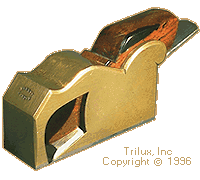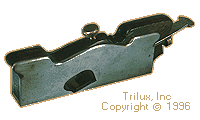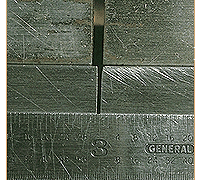

Company History |
| T. Norris & Son of London was established around 1860 and became the last surviving manufacturer of English infill planes, phasing out planemaking around 1941 in favor of wartime production. After World War II the name was carried on by Norris Planes and Tools Ltd., a subsidiary of Aeronautical and General Instruments. This company made a series of planes that while good are generally considered to be of lower quality. This operation ceased in 1952. |
Norris Bullnose
|
|
 |
Note the texture on the sides of the plane where abrasive paper was
rubbed to give a crisp linear matte finish. It also should be noted that the choice of
rosewood or ebony for any visible wood was not an extravagance, just a typical choice of
wood used for tools. However, inside the tool under the blade is a beech insert. Beech was
another less expensive wood that was commonly used for plane bodies. But, it is not known
whether beech was used because it was less expensive and easier to work than rosewood or
simply more suited to this application. Get a closer view of the object (70KB) View details of the object (42KB) |
| SPECIFICATIONS | ||
| DIMENSIONS | Width | 1 1/4" inches |
| Length | 3 7/8" | |
| Blade Thickness | 1/8" (nom.) | |
| MATERIALS | Body | Gunmetal Bronze |
| Sole | Steel | |
| Underblade Infill | Beech | |
| Wedge | Rosewood | |
| GENERAL | Year | C. 1928 |
| Cost in 1928 | 23/- shillings | |
Norris Shoulder Plane - No. 20E |
|
 |
Even after the invention of woodworking machinery when most of the
specialized planes lost their place of absolute necessity the shoulder plane retained it's
essential place in the workshop as a master tool for correcting and tuning. This
particular example is a little used late example of the highest grade tool Norris made. Get a closer view of the object (63KB) |
| SPECIFICATIONS | ||
| DIMENSIONS | Width | 1 1/4" inches |
| Length | 8" (sole only) | |
| Blade Thickness | 1/8" (nom.) | |
| MATERIALS | Body | Gunmetal Bronze |
| Sole | Steel | |
| Wood Infill | Ebony | |
| Underblade Infill | Beech | |
| Wedge | Ebony | |
| GENERAL | Year | C. 1930 |
| Cost in 1914 | 17/- shillings | |
| Cost in 1938 | 50/- shillings | |
Norris Shoulder Plane - No. A7 |
|
 |
In the last throes of the Norris company's existence, the company
offered for sale adjustable versions of most of their shoulder and bullnose planes. As the
tools were not offered until the end of the company's life and cost more than the
non-adjustable, these planes were never sold in great quantity. However, the mechanism is
ingenious and worthy of note. Get a closer view of the object (51KB) View details of the object (52KB) |
 |
Norris understood the importance of keeping the wooden
wedge as a blade clamp and damper against blade vibration. Once the wedge is inserted it
is tightened in place with a screw that bears onto a bronze insert to prevent it from
marking the wedge. Get a closer view of the object (82KB) |

|
The adjuster is a modified version of the double
thread system that Norris had used successfully since 1913 on their various bench planes.
A short post that sticks out from the adjuster engages a hole in the blade. Multiple holes
drilled in the blade are for adjustment as the blade wears. Get a closer view of the object (32KB) |
| SPECIFICATIONS | ||
| DIMENSIONS | Width | 1 1/4" inches |
| Length | 8" (sole only) | |
| Blade Thickness | 0.141" (nom.) | |
| MATERIALS | Body | Steel plates dovetailed together |
| Wood Infill | Rosewood | |
| Underblade Infill | Beech | |
| Wedge | Rosewood | |
| Mechanism | Steel | |
| Wedge Screw | Gunmetal Bronze | |
| GENERAL | Year | C. 1935 |
| Cost in 1914 | 37/6 shillings | |
Detail of a Norris Bronze Shoulder Plane showing Assembly numbers |
|
 |
Traditional tool makers made their tools by hand. This accounts for
the diversity of sizes and shapes within each style of tool. While there was a good deal
of specialization in toolmaking, the final mating of the parts of a plane were done by a
single craftsman. The cutter seat was filed to ensure that the blade lay flat. The body
and wedge were shaped so that the wedge precisely fitted the plane body and locked the
blade. Then the casting, blade, and wedge were stamped with the same number to ensure that
once fitted they could be reassembled after final polishing and lacquering. Get a closer view of the object (73KB) |
Detail of a Norris Bronze Shoulder Plane showing the narrow mouth |
|
 |
The key in producing a top-notch plane has always been in forming (among other attributes) a fine mouth. This is where the metal plane has always outshone its wooden ancestor. With the blade sitting bevel up, the plane body can provide support almost up to the cutting edge. This is essential for truly fine work and fine shavings. In many lower grade tools and in many tools that have either been worn out from use or modified by owners who wanted thicker, faster shavings the mouth of the plane has been widened. Mouths of Norris planes vary (possibly depending on the skill of the particular craftsman who made the plane) but the mouth of this particular plane, which is pretty much in factory condition, is particularly fine. It is shown in comparison to the mouth of a Preston 1" shoulder plane, the example that is displayed below. In examination of many specimens the mouth of a Norris shoulder plane were always fine except, of course, in the case of owner neglect. Mouths of Preston planes seem to vary from the very fine (but not as fine as Norris) to the really wide and yawning. Get a closer view of the object (211KB) |
Copyright 1999 01 Inc., NYC